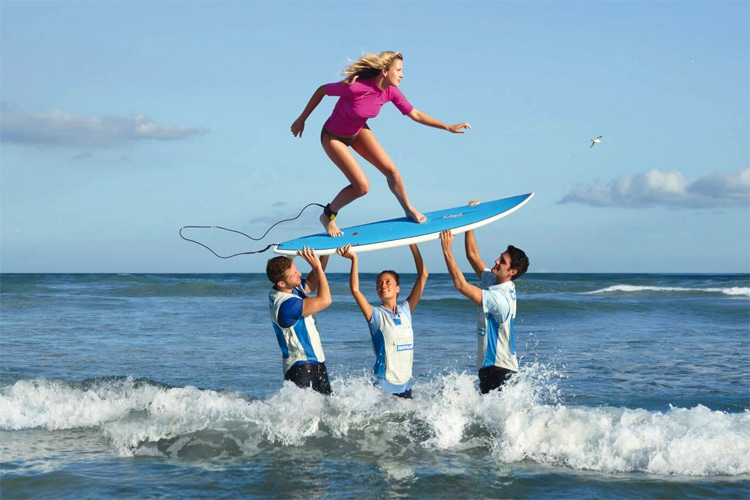The embarrassing use of surfing in advertising

If you’re a seasoned surfer or have been somehow connected to the intricate web of surf culture for a while, you’ll probably agree that there is nothing more embarrassing than witnessing non-surf brands using surfing as a marketing tool.
The word “impact” is a meaningful expression and concept in any marketer or advertising professional’s semiotic universe.
To put things simply, in the marketing world, it’s all about multiplying the customer’s investment in a campaign, i.e., maximizing sales of a product or service.
The world’s greatest creative geniuses have shown that sometimes, a word or a simple image can revolutionize the consumers’ perception of a brand.
However, sometimes, using signs and symbols that have forever touched people’s imagination and dreams is easier and more effective.
Surfing has recurrently been one of advertising’s best imaginary friends, with surfers and the practice of gliding across the face of an excitingly alive wave lending their reputation for the sake of selling more or less questionable products and services.
Paradoxically, surfing became a pastime and later a sport, thanks to its promotion by Hawaiian tourism authorities, Waikiki hotel owners, and cruise ship companies in the early 20th century.
“Visit Hawaii and try our latest beachside attraction: surfboarding.”
And so did mainland Americans, followed by Europeans and the rest of the world.

Surfing Sells
Soon, surfing was one of the coolest things middle-class families could aspire to try and embrace.
“Most surf-themed print ads between the 1920s and 1950s had to do with travel promotion for companies like Matson Line cruises, or tropical grown foods and beverages like Dole Pineapple,” notes surf historian Matt Warshaw, author of “The Encyclopedia of Surfing.”
“As surfing boomed in the late 1950s and 1960s, slipstreaming in large part behind the consumer powerful teenage baby boomers, advertisers began putting the sport to use for an expanding range of products and services, including obvious youth market items like Coca-Cola and the inexpensive Buick Opel sedan, as well as more imaginative wares like Cutex’s ‘Hang Ten’ nail polish (available in ‘Shoot the Curl Coral’ and ‘Wipe Out Pink’), Canadian Club whiskey, Salem cigarettes, and Clairol Sudden Summer hair lightener.”
While the early uses of surfing to sell non-surf-related goods and services could be understood considering the fact that surfing was a new (or the latest) “thing,” the association eventually escalated to disconcerting and, oftentimes, degrading campaigns.
If you found that using surfers to sell cigarettes is a bad idea, please do know that that was just the tip of the iceberg.
In the aftermath of Bruce Brown’s 1964 “The Endless Summer,” it felt like everything could be marketed via the sport of kings.
In the 1970s, but particularly more intensively in the 1980s and 1990s, surfing became a symbol of a healthy yet acceptably and excitingly rebellious generation.
Marketers, creatives, and advertisers learned that surfing sells – maybe even more than football/soccer, the world’s most popular sport.
And with the help of another lousy surfer named Hollywood, the express train to quick sales caught the wave.
Sadly, when surfing was the main topic of a script, the California mainstream film industry has never quite nailed it.
Hollywood drowned surfing in a sea of clichés and commonplaces and still haunts the sport and its devoted participants to this day.

Everybody Rides a Wave
However, the mass exposure Hollywood gave to surfing, for example, with blockbusters like “Gidget” and “Point Break,” only fueled marketers’ obsession with riding waves.
The level of absurdity in the marketing and advertising world reached unprecedented levels of embarrassment here and there.
To use a similarly cheesy association, one could say it was a “swell of wipeouts.”
Some campaigns were even removed, such as Mick Fanning’s shark attack parody advert by KFC.
In the blink of an eye, surfing was being used to sell a large category of products and services, including:
- Insurance policies;
- Consulting services;
- Banking products;
- Credit cards;
- Soft drinks;
- Beers;
- Coffee;
- Chocolate and candies;
- Cookies and biscuits;
- Breakfast cereals;
- Perfumes;
- Tampons;
- Shampoos;
- Skincare;
- Toothpaste;
- Allergy pills;
- CBD oils;
- Baby care products
- Smartphones;
- Computers;
- Gadgets;
- Phone and cable TV plans;
- Department stores;
- Shopping centers;
- Sports footwear and apparel;
- Cars;
- Airlines;
These are just a few examples, and if you doubt it, just Google them after “surfing ads and commercials.”

The Temptation Is High
Apple, for instance, named one of its operating systems, OS X Mavericks, as a tribute to the infamous Northern California wave. It could be worse.
However, surfers have rarely had any control of this hoarding by the business and creative world.
When they did, they accepted to be part of the show with unexpected outcomes.
“A partial list of famous surfers who have done advertising work includes Duke Kahanamoku for Sears, Roebuck and Co, Tom Blake for Matson Line, Mickey Dora for Oldsmobile, Nat Young for White Stag, Joyce Hoffman for Triumph, Corky Carroll and Rob Machado for Miller Lite, Mark Richards for Kentucky Fried Chicken, Wayne Bartholomew for Smirnoff, Cheyne Horan for Sunkist, and Laird Hamilton for Nike,” adds Warshaw.
But there were also legal battles taking place between surfers and the corporate world.
In 1999, three surfers from the longboard era – George Downing, Paul Strauch, and Ben Aipa – filed a $5 million defamation lawsuit against the clothing company Abercrombie & Fitch.
The lawsuit stemmed from the unauthorized use of a 1965 photo of the surfers in the middle of a four-page advertisement featuring nude surfers, shot by renowned fashion photographer Bruce Weber.
By 2003, the case had yet to be resolved.

Marketers Don’t Surf
Ultimately, most ads and commercials featuring surfers and surfing are profoundly humiliating and cringe.
Whether they’re a commercially resounding success is another question.
The truth is the freedom appeal, freshness, and liberating feeling and sensations that come with the act of riding a wave can rarely be mimicked even by the brightest marketing creative.
The exceptions are truly rare. The rule of thumb for marketers is, “Stay away from surfing. You’ll make a fool of yourselves again and again.”
One will always prevail, though, and it’s the famous “Guinness Surfer” commercial. But that is a very different story.
Words by Luís MP | Founder of SurferToday.com



